Whether you’re shooting with a disability or coaching someone with one, there are several important things to be aware of says Danielle Brown
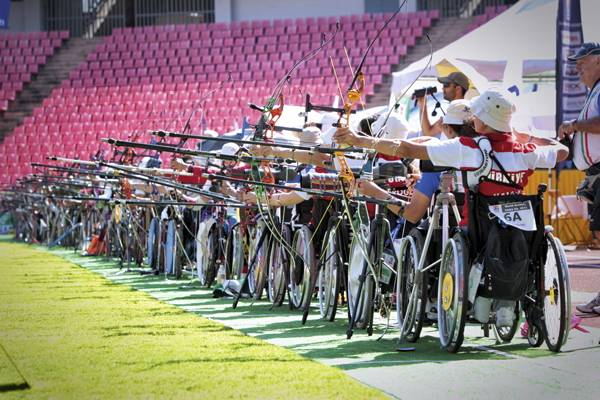
Disabilities affect everyone in different ways, but archery can be adapted to suit almost anyone that wants to take part
Governments and sporting bodies have tried to categorise disability the world over, but due to the complex nature of disability this is an impossible task. No list can ever accurately reflect the entire human condition. Even people labelled with the same condition or impairment will react to it differently, therefore it is extremely difficult to come up with a comprehensive list of advice that will suit everybody. Using my own experience and the advice from Helen George and Bob Smith, two notable British coaches specialising in working with disabled archers, I have come up with some practical suggestions for archers with an impairment of any kind. This will also hopefully help coaches adapt their approach to archers with disabilities, allowing more people to get involved with a sport which really is suitable for all!
Firstly, there are the categories of disability recognised by World Archery and the IPC, and then there are the people like me. The misfits that are not classified as disabled, yet are physically unable – or indeed unsafe – to draw a bow back without putting themselves and others in danger. However, simply because you do not fit into the rigid Paralympic categories does not mean that you cannot shoot without using assistive devices to help you. This might be a block under one foot, a mouth tab, a stool, or even a wheelchair. Classification is only necessary if you intend to enter tournaments under World Archery rules with an assistive device, or want to get involved with bodies like the British Wheelchair Archery Association (BWAA), and so it should not be a hindrance to anybody taking part in archery.
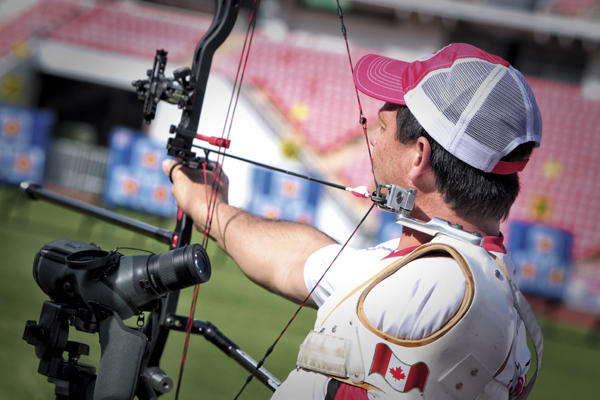
Assistive devices help disabled archers shoot to the best of their ability, but modifications will often be very personal and require ingenuity on behalf of the archer and coach
Physical disability can have an impact on your technique. The great news is that there is more than one way to shoot a bow. You can definitely do it, you might just have to find a different way of doing it! Coaches need to be aware of their archer’s capabilities – what they can do safely without injuring themselves. And don’t be afraid to ask! With an invisible disability like mine, people often jump to conclusions when they see me in a wheelchair one minute and then I’m up and walking about the next. I’d rather explain my condition and how it affects me so that whoever I’m working with (or anybody else that might be interested for that matter) understands the level of support that I need. It doesn’t help me if people are too frightened of causing offence to ask!
Understanding the nature of an impairment and how it affects the archer’s ability to shoot then allows you to move forwards and consider whether an assistive device is needed. Safety is a paramount concern, to ensure that the archer does not injure themselves any further or make their condition worse. The aim of any assistive device is to level the playing field, allowing archers to shoot to the best of their ability. In every case it is important that you address the individual’s needs, finding the adaptation suitable for them. Sometimes this will require a lot of ingenuity on the part of the coach and archer. Personal equipment often needs modification. Wheelchairs, for example, are great for moving around in but don’t provide the right support when shooting. If this is the case, you may have to fashion a more stable back support.
A question that I get asked on a regular basis is where I got my stool from. I was fortunate enough to be awarded a government grant from UK Sport and they had Loughborough University design and make my stool to my exact specifications. The angle and height suit my leg length and style of shooting, getting me into the position I want to be in. This is a very individual thing and unfortunately it is just a case of trial and error until you find something that works for you. Before I had my current stool built for me, my teammate Fred Stevens knocked a prototype together from a couple of bikes we got from Freecycle. My first stool was adjustable and allowed me to find my perfect set-up. The only regulation that needs to be followed is that the footprint of the stool can be no wider than 60cm and no longer than 80cm, including the length of your feet. Shower stools, drum stools and other perching stools are all suitable, so if you think you would benefit from shooting sitting down then have a look at these.
In my first couple of years of archery – before my balance decided to desert me completely – I used to stand to shoot. I had a terrible stance, leaning backwards, and most coaches would look at me, shrug and say, “It’s because of your disability.” Because my brain struggles to register where my body position is I found it insanely difficult to make the necessary corrections. It took quite a bit of searching before I found a coach who dared to try and change this. He suggested that I lean forwards at the start of the shot in order to counteract my lean, and eventually I learned how to (almost!) shoot standing up properly. Sometimes it requires thinking out the box, which prescribes to my philosophy that there is no mould for the perfect archer. Finding solutions for the individual is hugely important whether your athlete is able-bodied or not, the premise of which is always to understand the athlete you’re working with. Very few coaches have actually tried shooting from my stool, resulting in them trying to force changes that are physically impossible for me to do because of the position my body is forced into when sitting down. Adapt techniques to find something that works, encompassing the needs of the individual and their disability.
Preparation is prerequisite for success at any level. This is especially the case when you have a disability to contend with, helping you reduce the impact that your disability has on your performance. If you want to get the most out of yourself then you need to pay attention to how your body reacts to certain conditions and circumstances. It can be tremendously cold sat out there in the rain all day, unable to move about to keep yourself warm. If, like me, you struggle with the cold, make sure you invest in warm clothes that you can shoot in. Disabilities can be draining, so this is something for you to factor in when planning your competition calendar for the year. Building rest into your program at the optimal time will mean that you are physically in the best shape to compete. Developing good, consistent technique doesn’t always mean shooting your competition bow. Using resistance bands, shot trainers, light poundage bows and mental rehearsal techniques greatly extends the range and location of training that can be undertaken, which is convenient if you’re having a bad day and struggling to get out of the house.
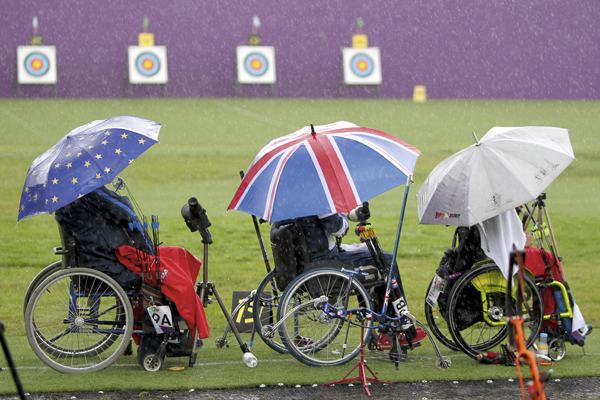
Pay attention to how your body reacts in certain conditions and build that awareness into shoot planning
However, because of the arbitrary nature of disability, no matter how well you prepare and how hard you work, sometimes you have to perform when you’re not feeling physically at your best. Lots of research out there advises that you shouldn’t train when you’re sick, but unfortunately disability doesn’t go away and often enough you just have to grit your teeth and learn how to work with it. It’s easy to give up and crawl home in defeat, but sticking it out is far more rewarding when you eventually make the end of the day. Of course if you’ve got an important tournament coming up in the next few weeks then persevering might not be sensible if you’re going to spend days recovering. But on those really bad days distracting yourself with visualisation exercises between ends can be really valuable.
Disability makes sport a little more difficult, just as it makes life that bit more difficult. That does not mean that it isn’t possible to perform well even when you’re having a really bad day. Barriers exist for disabled archers of all levels and abilities, but having the mental capacity to climb over them, however graceless and clumsy, is the drive that will see you succeed in any capacity. It might be impossible for you to train at the same frequency and intensity as an able-bodied archer, but there is no reason that you can’t achieve similar results if you learn how to train smarter.


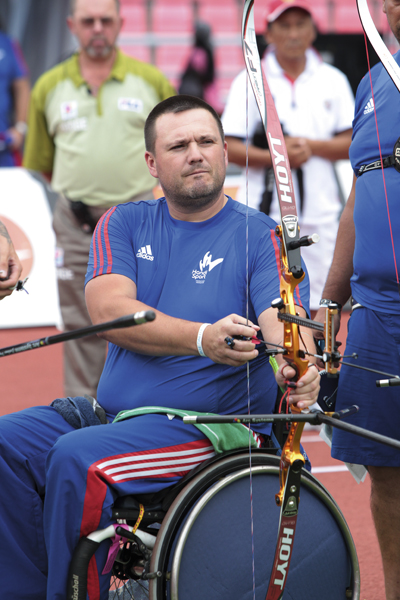
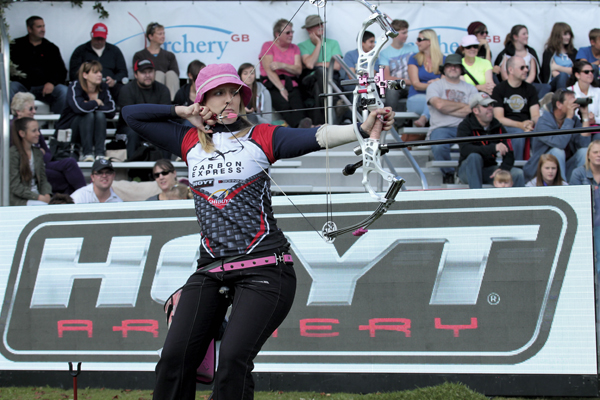
Hi there,
I am an outdoor instructor based in Hampshire, UK and I am trying to specialise a bit more in Archery. I have been teaching it for 8 years now and have loved the sport since I was very young. I started at my new centre in April 2022 and over this coming winter I have been tasked with improving and updating all of the archery equipment and range. One thing I would very much like to try and work on as a team and as a centre, is our adaptations for disabilities. We have lots of schools and groups in that have people that would otherwise struggle with the archery set up that we have and to be able to fully include everyone of all abilities is something that I am quite passionate about. I have begun to research all of the different types of equipment and adaptations to ranges to aid with this, but one this I am struggling is sourcing the equipment for it and the training. Is there any way you might be able to help me with any of this? Maybe just places to find the adaptive equipment or trainers that would be willing to attend the site and help out with this.
Thank you very much, and I look forwards to hearing back from you about this.
Emilie Foster-Starr
Hi Emelie – I don’t have any details to help here but get in touch with ArcheryGB, they will have some details that can help you